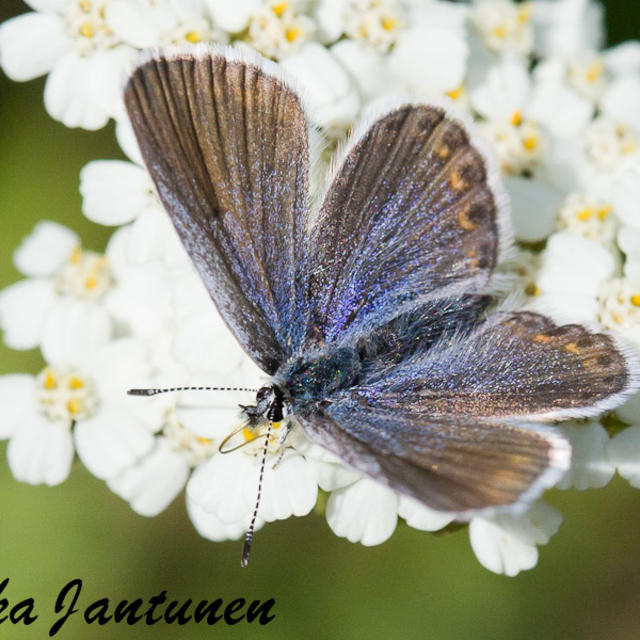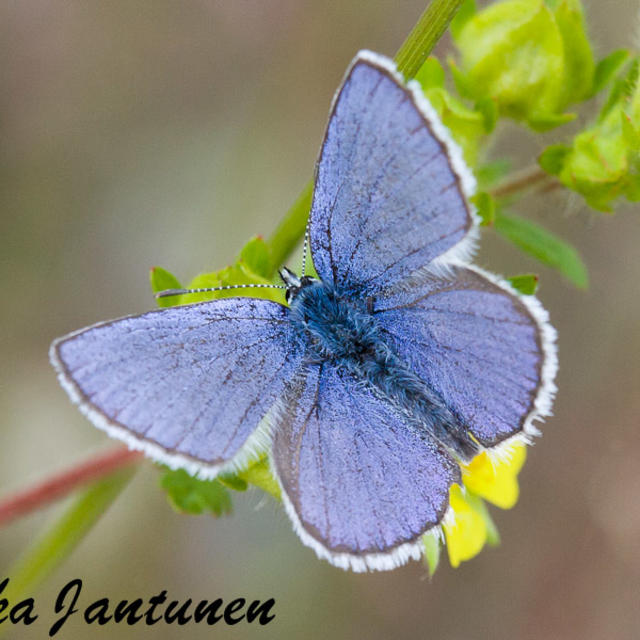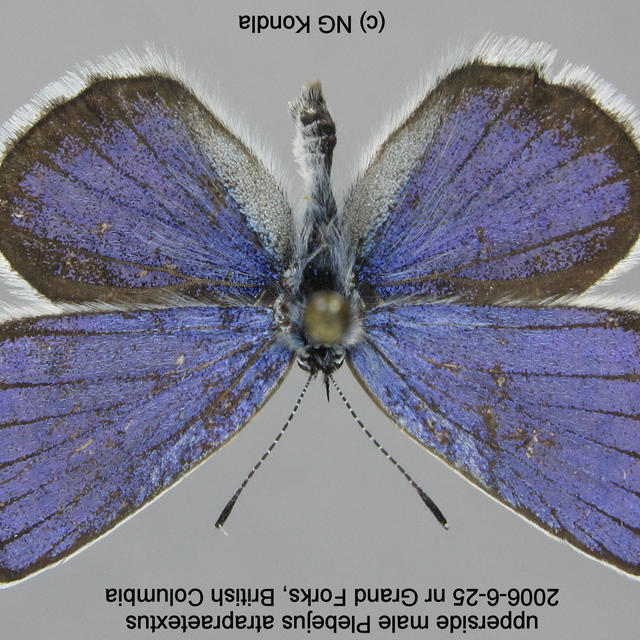Northern Blue
Plebejus idas (Linnaeus, 1761)
Family: Lycaenidae
Subfamily: Polyommatinae
Identification: Geographically variable. Upperside of male iridescent blue, female brown with orange submarginal spots. Below, hindwing has a thin black line along outer margin which is broken into small dots at vein ends. Can be positively identified only by dissection of male genitalia and by locality.
Wing Span: 7/8 - 1 1/2 inches (2.2 - 3.8 cm).
Life History: Males patrol near host plants for females. Eggs are laid singly on stems of host plant or in debris beneath it. Second-stage caterpillars overwinter.
Flight: One brood from July-August.
Caterpillar Hosts: Plants of the heath family (Ericaceae) in the east; legumes of the pea family (Fabaceae) in the west.
Adult Food: Nectar from flowers including yarrow; dogbane; orange hawkweed; and white, alsike, and hop clover.
Habitat: Openings in mixed evergreen forests, bogs, wet meadows, seeps.
Range: Holarctic. Nova Scotia west through the Great Lakes area and southern Canada; north to Alaska; south to central California, southern Idaho, and southwest Colorado.
Conservation: Subspecies lotis is probably naturally rare with low population densities; it is found currently in only 1 out of 7 of its historic sites. Successional changes in vegetation due to human disturbance choked out the host plant Lotus formosissimus. Subspecies lotis has The Nature Conservancy rank of T1 - Critically imperiled because of extreme rarity (5 or fewer occurrences, or very few remaining individuals), or because of some factor of its biology making it especially vulnerable to extinction. (Critically endangered throughout its range). The species as a whole has The Nature Conservancy Global Rank of G5 - Demonstrably secure globally, though it may be quite rare in parts of its range, especially at the periphery.
NCGR:
Management Needs: The U. S. Fish and Wildlife Service recovery plan for the Lotis Blue cites the need for basic biological and ecological information about this butterfly. Three steps to recovery are listed: 1) protect remaining habitat and butterflies at the only known population site, 2) establish 3 new populations at different sites, and 3) determine the extent of the population and the size of secure habitats needed.
Please donate!
We depend on donations to keep Butterflies and Moths of North America freely available. We want to express our gratitude to all who showed their support by making a contribution this year. You can donate to support this project at any time.
Advertise with us!
Do you have a product or service that you think would interest BAMONA users? If you would like to advertise on this website, contact us by email, or use the contact form and select the "Advertising" category.
Verified Sightings
Displaying 1 - 24 of 228 verified sightings

Observation date: Jul 28, 2025
Submitted by: mstanek
Region: Flathead County, Montana, United States
Verified by: J_Martineau
Verified date: Aug 07, 2025

Observation date: Jul 17, 2025
Submitted by: Ed Rothwell
Region: Spokane County, Washington, United States
Verified by: davidwdroppers
Verified date: Jul 21, 2025

Observation date: Jul 17, 2025
Submitted by: creekwalking
Region: Polk County, Iowa, United States
Verified by: James Steen
Verified date: Jul 17, 2025

Observation date: Jul 15, 2020
Submitted by: jrmbutterfly
Region: British Columbia, Canada
Verified by: James Steen
Verified date: Jun 06, 2025

Observation date: Jul 15, 2020
Submitted by: jrmbutterfly
Region: British Columbia, Canada
Verified by: James Steen
Verified date: Jun 06, 2025

Observation date: Sep 01, 2024
Submitted by: jrmbutterfly
Region: Alberta, Canada
Verified by: Paul Prappas
Verified date: Oct 19, 2024

Observation date: Jun 27, 2024
Submitted by: James F Parker
Region: Southeast Fairbanks, Alaska, United States
Verified by: davidwdroppers
Verified date: Oct 08, 2024

Observation date: Jul 29, 2024
Submitted by: ncrosbyrd
Region: Carbon County, Montana, United States
Verified by: J_Martineau
Verified date: Sep 04, 2024

Observation date: Jul 23, 2024
Submitted by: John Gibbons
Region: Quebec, Canada
Verified by: jmgesell
Verified date: Aug 04, 2024

Observation date: Jul 24, 2024
Submitted by: John Gibbons
Region: Quebec, Canada
Verified by: jmgesell
Verified date: Aug 02, 2024

Observation date: Jul 09, 2024
Submitted by: terrymortier
Region: Cook County, Minnesota, United States
Verified by: jmgesell
Verified date: Aug 02, 2024

Observation date: Jul 29, 2024
Submitted by: John Gibbons
Region: Newfoundland and Labrador, Canada
Verified by: jmgesell
Verified date: Aug 02, 2024

Observation date: Jul 25, 2019
Submitted by: ncrosbyrd
Region: Teton County, Wyoming, United States
Verified by: J_Martineau
Verified date: Jul 22, 2024

Observation date: Jul 19, 2023
Submitted by: Ed Rothwell
Region: Nova Scotia, Canada
Verified by: jwileyrains
Verified date: Jan 18, 2024

Observation date: Aug 25, 2023
Submitted by: appletree
Region: Glacier County, Montana, United States
Verified by: stevekohler
Verified date: Sep 12, 2023

Observation date: Aug 13, 2023
Submitted by: Jenneill
Region: Ouray County, Colorado, United States
Verified by: mikefisher
Verified date: Sep 10, 2023

Observation date: Jun 24, 2022
Submitted by: Rick Sinnott
Region: Denali, Alaska, United States
Verified by: davidwdroppers
Verified date: Aug 21, 2023

Observation date: Jul 30, 2022
Submitted by: scsmith1957
Region: Alberta, Canada
Verified by: Paul Prappas
Verified date: Feb 20, 2023

Observation date: Jul 19, 2020
Submitted by: jsaunders260
Region: Matanuska-Susitna, Alaska, United States
Verified by: Paul Prappas
Verified date: Feb 10, 2023

Observation date: Jul 19, 2020
Submitted by: jsaunders260
Region: Matanuska-Susitna, Alaska, United States
Verified by: Paul Prappas
Verified date: Feb 07, 2023

Observation date: Aug 09, 2019
Submitted by: Aat
Region: Alberta, Canada
Verified by: Paul Prappas
Verified date: Feb 07, 2023

Observation date: Aug 09, 2019
Submitted by: Aat
Region: Alberta, Canada
Verified by: Paul Prappas
Verified date: Feb 07, 2023

Observation date: Aug 06, 2022
Submitted by: Bob Patton
Region: Montana, United States
Verified by: stevekohler
Verified date: Jan 18, 2023

Observation date: Jun 22, 2022
Submitted by: jrmbutterfly
Region: British Columbia, Canada
Verified by: davidwdroppers
Verified date: Nov 03, 2022
- 1 of 10
- next ›










